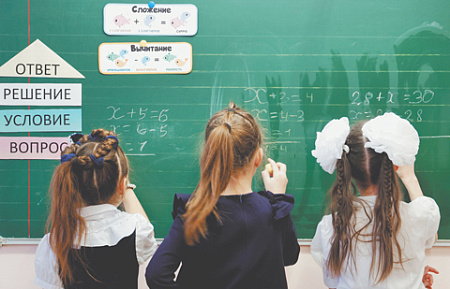
Both before and today, schools often practice mixing classes when moving to new levels: from elementary to middle, from middle to high school. The goal is clear: to form classes according to the profile or according to the principle of equally successful students. Previously, this was sought mainly in high school, but today it is often thought about already at the stage of transition from elementary school to secondary school. Is this a good thing or a bad thing?
Transfer from primary school to secondary school is a turning point in a child’s life, as the transition to a new lifestyle, to new working conditions, to a new position in society, to new relationships with adults, peers, and teachers is underway. In the childhood of the older generation of Russians, elementary grades were transferred to secondary school as a whole. But today, in some schools, it has become fashionable to form specialized classes from the 5th or 7th grade. Their selection is based on assessments and coordination with parents.
How are children usually redistributed? It all depends on the specific school. In this selection, it can rely on current assessments, the result of the All-Russian Verification works, on its own testing, etc. Although everyone recognizes that today, due to subjectivity and ambiguity of interpretation, the idea of mass testing in pedagogy and psychology has already lost its influence on schools.
As for the VPR, they appeared relatively recently. This, of course, is not the OGE or the Unified State Exam, although there is clearly a common one. For example, schoolchildren write their papers on special forms in the same way. At the same time, the student’s last name is not indicated on the form – only the four-digit code assigned to him. This anonymity is necessary for unbiased verification of assignments.
It is assumed that officials of the Ministry of Education of the Russian Federation evaluate schools and teachers with the help of VPR. If the results of the VPR in some schools are lower than in others, it means that she needs help, and it will be provided. But when forming new classes, schools can also pay attention to the results of the VPR.
If a child does not get into a “specialized” class, then he goes to a “general education” class. It has become common for parents, and indeed for schools themselves, to think that students who have not shown themselves in their studies or in public life are being gathered there. And I know cases when children were so upset about getting into this class that they left this school. It is better to go to a school where all classes are comprehensive than to be a “second-class” person.
Russian scientists, based on experimental data, look at this situation of early division in a slightly different way than schools striving for such a division. Alexander Savenkov, a psychologist and corresponding member of the Russian Academy of Sciences, told NG that at one time he even wanted to create his own program by analogy with the Western one, which is called “A gifted child in a mass school.”
“It’s great to create schools or assemble classes where there will be only capable children,” says the psychologist. – But let’s be honest: who will we create favorable conditions for? For teachers. But children will get a whole bunch of psychosocial problems. This child felt like a leader. And who did he become in this “elite” school, where the same or even more talented than him gathered? He no longer feels the euphoria of the experience of intellectual leadership, but feels like an outsider.”
From this greenhouse called the School for the Gifted, the child will return to the ordinary world, to which he is not adapted, the scientist believes.
Or here’s another example. Somehow, psychologists decided to find out how students’ abilities are related to their academic performance. How reasonable is the division into twos and “golden” students? At the very beginning of the experiment, the researchers resorted to some tricks. They announced testing, but did not report which one. After testing, the students were secretly divided into two groups: “gifted students” and “ordinary students.”
The trick was that the testing was actually a pure fiction, and the children were randomly divided. The teachers were informed of the status of the children in the groups: some were “gifted” and others were “normotypical”. And they asked me to keep this information secret. Prior to the experiment, the academic performance of each student was recorded. There were both twos and honors students, good ones and threes.
The experiment took place for one quarter, but even this short time was enough to draw interesting conclusions. All the students from the “gifted” group began to study better. Those who had previously moved from two to three, steadily began to move to four in this group. And it’s the other way around in a group of ordinary guys. Even the high-achieving students began to lose results, their grades became noticeably worse (not much, but there was a trend).
These data have been subjected to statistical processing. It showed the highest correlation… the influence of the teacher’s “attitude towards the student”. If the teacher’s attitude was positive, that is, he saw a “gifted” student in front of him, then he unconsciously created all the conditions so that in reality it would meet his expectations. For example, he overestimated grades, and working with a student was more in-depth and responsible, which could not but affect his understanding of the material and, consequently, his academic performance.
These are the results. And conclusions will have to be drawn not only by the heads of the Ministry of Education, but also by parents. One can imagine what kind of plume of collisions will arise and what it will lead to.
